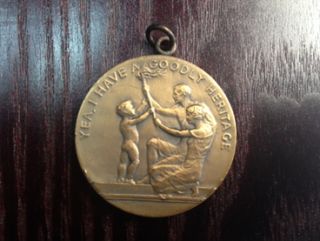
Health
Judging the Baby Crop
How eugenic baby health contests shifted focus to family heredity
Posted July 22, 2015

Guest post by Natalie Oveyssi.
Forgotten Stories of the Eugenic Age is a guest blog series by Natalie Oveyssi exploring the lesser-known ways that eugenics affected and engaged American lives during the first half of the twentieth century.
Eugenics became a popular ideology in the United States beginning in the second decade of the twentieth century. Concerned with producing a stronger and fitter population through the careful and often coercive control of reproductive behavior, eugenics captured the attention of a citizenry eager to use science to solve its social problems.
Many scholars divide the early eugenics movement into two branches: “positive” and “negative” eugenics. Positive eugenics was the encouragement of reproduction for those believed to be of superior hereditary stock, in contrast to “negative” eugenics, the discouragement or prevention of reproduction for those deemed hereditarily “unfit.” Many eugenists, as eugenic advocates were known, believed that the goals of positive eugenics could be achieved voluntarily through education campaigns, while negative eugenic aims would require more coercive means for attainment, such as mass sterilization and immigration quotas.
Baby health contests at agricultural and state fairs perhaps most vividly exemplify popular campaigns for positive eugenics. Judges at these contests examined infant contestants according to a set of criteria for physical health and intelligence that included factors such as shape of the head, width between the eyes, condition of tonsils, strength of spine, and ability to walk or crawl. They quite tellingly employed scorecards derived from those used to judge livestock. First begun in 1908 at the Louisiana State Fair, baby health contests spread to forty states within just a few years.
However, somewhere along the eugenic line, "Better Baby" contests, as they were known, morphed into "Fitter Family" contests that examined not only the baby but the whole family. Scholars have attributed this change to a shift in focus from the health and development of the child towards a more comprehensive look at hereditary history, in keeping with the principles of eugenics. But how exactly did this change transpire?
Mary T. Watts, co-founder of the Better Baby contests, revealed the impetus for the transformation in an address at the Thirty-third Annual Meeting of the International Association of Fairs and Expositions in 1923.
As Watts recounted, shortly after she began the Better Baby contests in her home state of Iowa, she received a letter in the mail from none other than Charles B. Davenport, a titan of the eugenics field. Davenport wielded significant influence as the director of the Biological Laboratory at Cold Spring Harbor, the Eugenics Record Office, and the Carnegie Institute of Washington’s Station for Experimental Evolution.
On a one-cent postcard, Davenport had written only, “You should give 50 per cent to heredity before you begin to score a baby.” Overwhelmed by answering inquiries from intended Better Baby organizers across the United States and Canada, Watts placed the letter aside and forgot about it.
The following year, she received yet another terse postcard from Davenport with the single ominous sentence, “A prize winner at two may be an epileptic at ten.” Watts, who had since become aware of Davenport’s authority in eugenics, understandably found the postcard “so startling it could not be ignored.”
Watts shared Davenport’s letter with her Better Baby co-founder, Dr. Florence Sherbon, who noted that many prize-winning babies likely had alcoholic fathers, diseased mothers, or insane relatives. Perhaps Davenport was on the right track; rather than examining babies alone, in order to truly test for eugenic ideals, judges must look to a baby’s family as well. How else could they tell if a baby was “better”?
Watts and Sherbon decided that they wanted to insert family and heredity tests into the contests, but were concerned that doing so would eliminate their popular appeal. It took the pair six years to develop a satisfactory approach. They presented their plan for Fitter Family contests to a group of experts who offered a mixed response.
The experts universally approved of the reasoning behind the new plan, but felt that Fitter Families would not be able to replicate the smashing success of Better Babies. Watts recalled that the experts said, “You can bring the baby to the fair because he cannot help himself, but you will never get the fathers and mothers to a fair for physical and mental examinations.” The experts were especially concerned that adults would not submit to the Wassermann test for syphilis, presumably because some would not want their spouses to discover the results.
Nonetheless, the experts assisted in making a scorecard to judge not only the babies’ physical and mental qualifications, but also those of their parents and siblings. All were shocked when twenty families entered the first Fitter Family contest at the Kansas Free Fair in 1920. The Fitter Family contest organizers continued their newfound relationship with Davenport well into the 1920s, as Sherbon and Watts sought his advice on their family history forms and contest procedures.
Critics of the Fitter Family plan had said that “we could never hope to interest educated, self-respecting families in physical examinations for adults at a fair ground.” But, Watts stated proudly in her 1923 address, the Fitter Family contests were thriving. And the organizers and contestants—as well as the eugenic cause—could thank Charles Davenport, whose postcards had provided the spark that lit the fire.
Sources:
1. Lovett, Laura L. “‘Fitter Families for Future Firesides’: Florence Sherbon and Popular Eugenics.” The Public Historian 29, no. 3 (Summer 2007): 69–85. JSTOR.
2. Selden, Steven. “Transforming Better Babies Into Fitter Families: Archival Resources and the History of the American Eugenics Movement, 1908–1930.” Proceedings of the American Philosophical Society 149, no. 2 (June 2005): 199. EBSCO host.
3. Watts, Mary. "Fitter Families for Future Firesides." Billboard 35, no. 50 (Dec. 15, 1923): 230–231. ProQuest.

Natalie Oveyssi is a Summer Staff Associate at Center for Genetics and Society and graduated summa cum laude from UC Berkeley in spring 2015 with a B.A. in Sociology. She is interested in the intersections of science, society, and the law.



